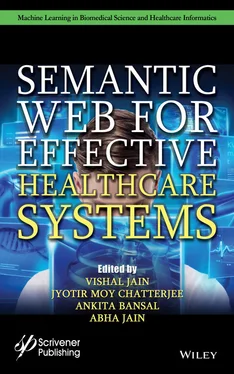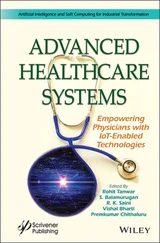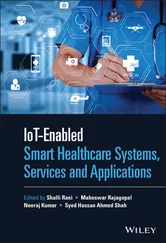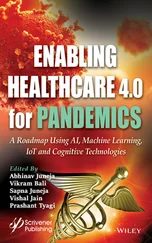1 Cover
2 Title page
3 Copyright
4 Preface
5 Acknowledgment
6 1 An Ontology-Based Contextual Data Modeling for Process Improvement in Healthcare 1.1 Introduction 1.2 Related Work 1.3 Motivation 1.4 Feature Extraction 1.5 Ontology Development 1.6 Dataset Description 1.7 Results and Discussions 1.8 Applications 1.9 Conclusion 1.10 Future Work References
7 2 Semantic Web for Effective Healthcare Systems: Impact and Challenges 2.1 Introduction 2.2 Overview of the Website in Healthcare 2.3 Data and Database 2.4 Big Data and Database Security and Protection References
8 3 Ontology-Based System for Patient Monitoring 3.1 Introduction 3.2 Literature Review 3.3 Architectural Design 3.4 Experimental Results 3.5 Conclusion and Future Enhancements References
9 4 Semantic Web Solutions for Improvised Search in Healthcare Systems 4.1 Introduction 4.2 Background 4.3 Searching Techniques in Healthcare Systems 4.4 Emerging Technologies/Resources in Health Sector 4.5 Conclusion References
10 5 Actionable Content Discovery for Healthcare 5.1 Introduction 5.2 Actionable Content 5.3 Health Analytics 5.4 Ontologies and Actionable Content 5.5 General Architecture for the Discovery of Actionable Content for Healthcare Domain 5.6 Conclusion References
11 6 Intelligent Agent System Using Medicine Ontology 6.1 Introduction to Semantic Search 6.2 Sematic Search 6.3 Structural Pattern of Semantic Search 6.4 Implementation of Reasoners 6.5 Implementation and Results 6.6 Conclusion and Future Prospective References
12 7 Ontology-Based System for Robotic Surgery—A Historical Analysis 7.1 Historical Discourse of Surgical Robots 7.2 The Necessity for Surgical Robots 7.3 Ontological Evolution of Robotic Surgical Procedures in Various Domains 7.4 Inferences Drawn From the Table 7.5 Transoral Robotic Surgery 7.6 Pancreatoduodenectomy 7.7 Robotic Mitral Valve Surgery 7.8 Rectal Tumor Surgery 7.9 Robotic Lung Cancer Surgery 7.10 Robotic Surgery in Gynecology 7.11 Robotic Radical Prostatectomy 7.12 Conclusion 7.13 Future Work References
13 8 IoT-Enabled Effective Healthcare Monitoring System Using Semantic Web 8.1 Introduction 8.2 Literature Review 8.3 Phases of IoT-Based Healthcare 8.4 IoT-Based Healthcare Architecture 8.5 IoT-Based Sensors for Health Monitoring 8.6 IoT Applications in Healthcare 8.7 Semantic Web, Ontology, and Its Usage in Healthcare Sector 8.8 Semantic Web-Based IoT Healthcare 8.9 Challenges of IoT in Healthcare Industry 8.10 Conclusion References
14 9 Precision Medicine in the Context of Ontology 9.1 Introduction 9.2 The Rationale Behind Data 9.3 Data Standards for Interoperability 9.4 The Evolution of Ontology 9.5 Ontologies and Classifying Disorders 9.6 Phenotypic Ontology of Humans in Rare Disorders 9.7 Annotations and Ontology Integration 9.8 Precision Annotation and Integration 9.9 Ontology in the Contexts of Gene Identification Research 9.10 Personalizing Care for Chronic Illness 9.11 Roadblocks Toward Precision Medicine 9.12 Future Perspectives 9.13 Conclusion References
15 10 A Knowledgebase Model Using RDF Knowledge Graph for Clinical Decision Support Systems 10.1 Introduction 10.2 Relational Database to Graph Database 10.3 RDF 10.4 Knowledgebase Systems and Knowledge Graphs 10.5 Knowledge Base for CDSS 10.6 Discussion for Further Research and Development 10.7 Conclusion References
16 11 Medical Data Supervised Learning Ontologies for Accurate Data Analysis 11.1 Introduction 11.2 Ontology of Biomedicine 11.3 Supervised Learning 11.4 AQ21 Rule in Machine Learning 11.5 Unified Medical Systems 11.6 Performance Analysis 11.7 Conclusion References
17 12 Rare Disease Diagnosis as Information Retrieval Task 12.1 Introduction 12.2 Definition 12.3 Characteristics of Rare Diseases (RDs) 12.4 Types of Rare Diseases 12.5 A Brief Classification 12.6 Rare Disease Databases and Online Resources 12.7 Information Retrieval of Rare Diseases Through a Web Search and Other Methods 12.8 Tips and Tricks for Information Retrieval 12.9 Research on Rare Disease Throughout the World 12.10 Conclusion References
18 13 Atypical Point of View on Semantic Computing in Healthcare 13.1 Introduction 13.2 Mind the Language 13.3 Semantic Analytics and Cognitive Computing: Recent Trends 13.4 Semantics-Powered Healthcare SOS Engineering 13.5 Conclusion References
19 14 Using Artificial Intelligence to Help COVID-19 Patients 14.1 Introduction 14.2 Method 14.3 Results 14.4 Discussion 14.5 Conclusion Acknowledgment References
20 Index
21 End User License Agreement
1 Cover
2 Table of Contents
3 Title page
4 Copyright
5 Preface
6 Begin Reading
7 Index
8 End User License Agreement
1 Chapter 1 Figure 1.1 Decision-making process from social media reviews. Figure 1.2 User-generated content analysis (UCA) model. Figure 1.3 Term weighing schemes for feature extraction. Figure 1.4 Synonymy and polysemy issues in English. Figure 1.5 Approximated TD matrix by SVD. Figure 1.6 LDA framework. Figure 1.7 Plate notation of CFS LDAmodel. Figure 1.8 Ontology-based semantic indexing (OnSI) model. Figure 1.9 Domain ontology modeling for features. Figure 1.10 Ontology mapping using OnSI model. Figure 1.11 Spring view of domain ontology (DS1). Figure 1.12 Precision vs recall curve for the Dataset DS1. Figure 1.13 Hierarchy of MCDM problem. Figure 1.14 Ranking of features by VIKOR method.
2 Chapter 2 Figure 2.1 Sources of data in healthcare. Wikipedia contributors. (2021, May 11)...Figure 2.2 Conceptual architecture of big data.
3 Chapter 3Figure 3.1 Conceptual diagram for patient’s monitoring system.Figure 3.2 Ontology for patient’s monitoring system.Figure 3.3 Parse tree for patient’s monitoring system.Figure 3.4 SWRL for patient’s monitoring system.Figure 3.5 SPQRAL query for patient’s monitoring system.Figure 3.6 Comparison between SQL and SAPRQL.
4 Chapter 5Figure 5.1 (a) Sequential composition model; (b) Parallel composition model.Figure 5.2 Evolution of actionable content.Figure 5.3 Data to actionable content triangle.Figure 5.4 Spectrum of healthcare analytics.Figure 5.5 Model of ontology.Figure 5.6 Different types of ontologies.Figure 5.7 Block diagram for actionable content discovery.Figure 5.8 Overall architecture of ontology-driven actionable content discovery ...Figure 5.9 Inner mechanism of proposed architecture.Figure 5.10 Contextual dimension modeling diagram with data coming from various ...
5 Chapter 6Figure 6.1 Architecture diagram.Figure 6.2 Parse tree of medicine.Figure 6.3 Medicine ontology.Figure 6.4 Rules of construction.Figure 6.5 SPARQL query output.
6 Chapter 7Figure 7.1 The above figure represents a graph-based representation of meta-anal...Figure 7.2 The above figure represents a graph-based representation of meta-anal...Figure 7.3 The intraoperative results of the robotic-assisted mitral valve surge...Figure 7.4 The encounters of complications faced during the surgery by both grou...Figure 7.5 The postoperative results depict that the patients in Group II requir...
7 Chapter 8Figure 8.1 Phases of IoT process.Figure 8.2 IoT-based healthcare architecture.Figure 8.3 Semantic web-based IoT healthcare.
8 Chapter 9Figure 9.1 Examples of some ontologies.
9 Chapter 10Figure 10.1 CAP. Consistency and tolerance to network partition or availability ...Figure 10.2 Stages in the proposed model.
10 Chapter 11Figure 11.1 Disorders of tyrosinemia type II.Figure 11.2 UMLS metathesaurus relations.
11 Chapter 14Graph 14.1 Increase in life expectancy with the advancement in healthcare sector...Figure 14.1 Distribution of COVID cases across the world.Figure 14.2 Projections of the healthcare facilities present VS that we require.Figure 14.3 Three-stage model for critical care patients.
Читать дальше












